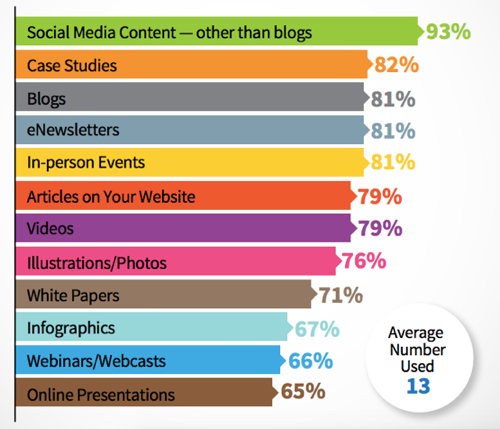Eight types of videos to engage your audience
We’ve all read the statistics on how video reaches three times more people and gets 20% more attention than regular blog posts.
So if audiences crave video, and if video gets you noticed, why is it that so few businesses serve it up to their prospects? Why is it that, despite it efficacy, video comes in at just number seven on the list of types of content used by brands?
Sure, producing a video may not be as easy or as cheap as writing a blog post. But what if the bigger challenge isn’t lack of time or resources, but lack of ideas? When it comes to getting started with video, many businesses are stuck at a roadblock, wondering how to diversify their video offering.
If that’s also the case with you, here are eight types of videos you can create to engage your audience. Now you have no excuse not to create video content that your viewers will enjoy.
Eight types of video content
1. Vlogs
Vlogs, or video blogs, are becoming a popular way for businesses to educate and entertain their audiences online. And users enjoy them because they’re fun to watch, and short enough so they don’t take up too much of their time.
So why should you use them? Because they’re engaging and cheap to produce. You don’t even need special equipment or mad editing skills. All you need is an idea and an outline of what you want to talk about, and then you can get in front of your webcam and shoot your four-five minute vlog.
A very popular and entertaining vlog is the one starring Blendtec founder Tom Dickson. Tom has managed to use vlogging to turn a boring household appliance into an Internet sensation. On the Blendtec vlog, Tom attempts to pulverise various items, including an IPad, a selfie stick and golf balls, using his blenders.
Just like with blogging, you need to be consistent if you want to take full advantage of vlogging and get a loyal audience who’s eager to tune in for your next vlogs.
Not sure if vlogging are right for your business? In this article we walk you through the pros and cons of vlogging so you can decide whether it’s worth investing your time and resources into.
2. Culture videos
This type of videos is great because it lets your audience see the human side of your company. So use them to show off your team, your secret sauce and the passion you have for your business (and your customers).
Check out these two examples from Apple and BambooHr:
You don’t need to be Apple or have a fairy-tale culture like BambooHr to share a company culture video with your audience. All you need to do is to find that unique, fun thing that differentiates your brand and makes it more human, more approachable and more alive. Think slice-of-life employee interviews, birthday parties, pranks, and everything in between.
The goal here is to show what your company culture looks like by giving your audience a behind-the-scenes look at what goes on in your office, and the people involved. If viewers enjoy it and relate to it, you’ll be more likely to gain brand advocates who willingly share your message and recommend your business to others.
Culture videos are also great at attracting the best and brightest when you’re looking to add new members to your team as people can see what it can be like to work with you.
3. Webinars and educational videos
Whether you realise it or not, you’re probably already creating this type of content. Maybe you’re using GoToWebinar to record a presentation for a few priority customers. Or maybe you’re using Google Hangouts to do a demo and walk your team through the new features of a product. Don’t just sit on it. Post it and let your whole audience benefit from that useful information.
Here’s one of our own examples, a webinar on how to develop your small business brand.
Remember: content you only use once is content wasted. So always think about additional ways you can leverage the content you’ve created. Has one of your recent blog posts received lots of comments and attention? Find a way to turn it into a webinar.
Just as running a great blog helps to establish your brand as an industry leader, providing your audience with educational videos can be an effective way to build trust and credibility with them, so make sure to take advantage.
Following are a few tools that you can use to hold your webinars:
Need help getting started with your first webinar? Check out these resources for some great tips and advice:
4. Product videos
There are very few things that can promote a product better than showing it in action to highlight its benefits. In fact, 52% of consumers say that watching product videos makes them more confident in online purchase decisions. More confidence means fewer returns and happier customers willing to share their experience with others.
Think about it: users like proof that a product works and looks the way they expect. So what better way to prove it than by creating a product video that shows why your product or service beats everything your competitors have to offer?
Product videos are also great conversion tools as, when done right, they can help prospects visualise themselves using it, which gets them one step closer towards buying.
Products such as the Amazon Echo benefit greatly from a video of it in use. This way users can get a sense for it in an everyday environment before deciding if it’s a product they want and need.
Product videos can make the perfect pitch by showing how your product or service solves a problem. And what makes them so effective is the use of storytelling. Just watch this video from Wizzki, an online hiring platform:
In the first seconds you follow a story with superheroes and villains, and then the brand is introduced as being the one that saves the day. So once the viewer is hooked by some fun storytelling, the rest of the video explains the problems that the app can solve.
5. FAQ videos
People have lots of questions and concerns before buying a product or service. FAQ videos are great for allaying their fears and calming any last quibbles before purchase. Use them and you’ll have a better chance of converting visitors into buyers without the assistance of a dedicated support team.
McDonald’s Canada has managed to score on the FAQ game by providing users with a plethora of informative videos that answer their questions. Here’s one:
6. How-to or instructional videos
What happens after customers buy from you? Will you be there to help them make the most of their purchase? With how-to or instructional videos, they’ll know the answer is Yes.
So whether you’re selling a piece of furniture or software, make sure to create a how-to video that explains how to use it post-purchase.
Check out this video example from Ikea:
And here’s another one from screen capture tool Snagit:
7. Testimonials
What better way to entice prospects to buy from you than showing the success of someone who’s already gone through the process? As with product videos, it’s all about getting them to imagine themselves using your product or service, and enjoying it.
FreshBooks shows off how they helped their customers in this testimonial:
Testimonials aren’t just those from your customers. They can also be from industry partners who have benefited from your collaboration, and even your own team where they talk about what it was like to be part of your latest project.
Here’s a simple example from Aldi, where an employee talks about the benefits of working there:
What’s great about testimonial videos is that you don’t need fancy equipment to create them. You can even use your smartphone to snap a video during an event or at the office after finalising a project.
8. Events
Attending an event or tradeshow? Make a video and share it with your audience. But instead of producing an expensive full-blown event video, now you can share snippets of it using Instagram, Facebook Live and Periscope.
But when it comes to live streaming and short-form video, go beyond events and use these fantastic tools to share anything from behind-the-scenes to how-to videos.
Here’s an example to show how you can create a splash with short-form video:
If you’re interested in learning more about these tools and how you can use them to market your business, check out these resources to get your started:
- Everything you need to know about Facebook Live and how it can help your business
- How to use Periscope to market your small business
Wrapping up
With so many free or low-cost tools, there’s no reason not to vlog, host webinars and snap short videos of your events. In fact, not using video to educate and entertain your audience is a definite content marketing crime.
There are plenty of types of video content that viewers enjoy, so try as many of these options as you can to see what works best for your business.









